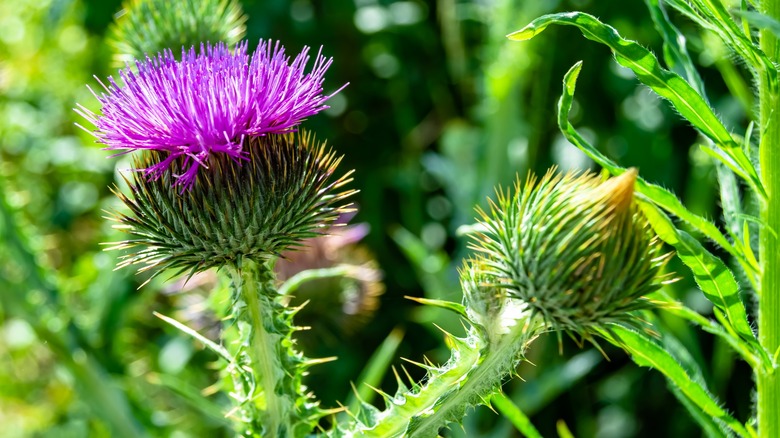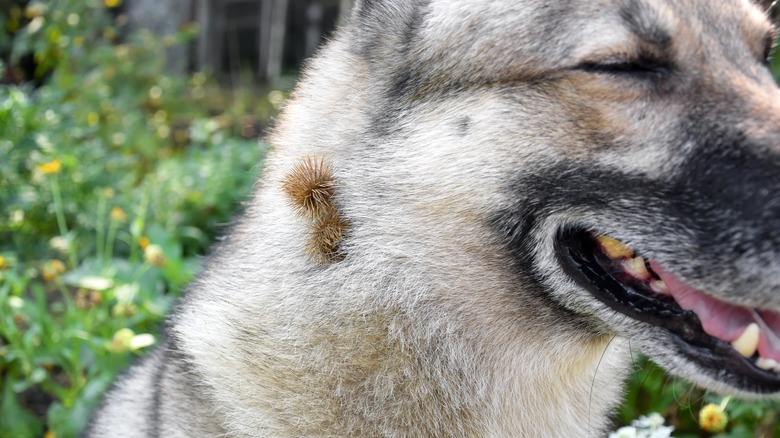Although bee-friendly, burdock is an extremely invasive weed that spreads prolifically and will end up all over your yard if you’re not careful. You can find it growing in your lawn or between your shrubs or veggies – wherever the soil is fertile and well-draining. You can recognize burdock by its big oval or triangular-shaped dark green leaves, with pale wooly undersides, and small purple, pink, and white spiky flowers.
Did you know that weeds are so resilient and determined to survive that some even deposit growth-inhibiting chemicals into the soil to sabotage other plants in the vicinity? Burdock’s aggressive strategy to take over your garden involves spreading its seeds far and wide. A single burdock plant can produce 15,000 seeds! This is why it’s really important to remove the flowers before they go to seed to stop the plant from spreading. This is because when the seed heads dry, they break off, and the seeds spread. Not only that, but the burrs are very good at getting about by getting caught up in the fur of pets, wild animals, and birds or on people’s clothes and shoes. Often, it’s better to remove the whole weed from the ground to eradicate future growth.
How to get rid of burdock in your garden

The invasive nature of burdock makes it a challenge to get rid of the weed completely, but not impossible. The plant’s life cycle is relatively short, living up to four years, and because it only propagates by seed, you may choose to simply contain the spread by removing flowers and cutting burs every August, ensuring that none are dropped on the ground.
However, you can’t guarantee the plant won’t spread, so instead, you can remove the whole plant from the base. This can be done by hand if the plant is young, by gripping it at the base of the leaves and slowly pulling it up, taking care to do so evenly so that the root doesn’t break. You can also dig the plant up to help loosen the root from the ground and avoid it snapping.
If the weed is more established it will develop a thick taproot that grows deep into the ground, reaching more than a foot in depth, making it much harder to remove completely. In this case, after pulling it up to expose the root, pour white distilled vinegar between the leaves to kill the plant by targeting the roots at the base. Make sure to saturate all the leaves, stems, and any visible roots.
Why should you get rid of burdock from your garden?

If you allow weeds to grow big and tall in your garden, they will compete with your other plants for nutrients and water. Burdock, when left alone, can grow up to 10 feet tall in its second year. It also has very large leaves that will create a lot of shade over your other plants. This means that small plants may perish as they compete for the sunlight they need to photosynthesize to produce food and grow. Plus, if you grow vegetables or fruit, the quality of your crop could be affected. The longer you leave burdock to grow in your garden, the harder it will be to remove it because the taproot will extend deeper and become very thick. If you aren’t able to remove all of the root system effectively, the weed will continue to grow back.
Burdock is also considered to be a harmful weed under the B.C. Weed Control Act and can cause harm to both humans and animals. The bristles of the burdock plant can result in an allergic reaction upon contact with skin. If you have pets playing in your garden, having burdock around could also lead to an expensive vet bill for the surgical removal of seeds, as they are notorious for causing casualties in livestock, such as eye infections, skin issues, and mouth sores.



